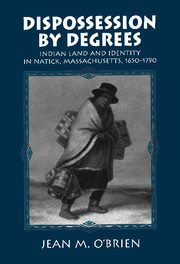Book contents
- Frontmatter
- Contents
- List of illustrations
- Acknowledgments
- Prologue: “My land”: Natick and the narrative of Indian extinction
- 1 Peoples, land, and social order
- 2 The sinews and the flesh: Natick comes together, 1650–75
- 3 “Friend Indians”: Negotiating colonial rules, 1676–1700
- 4 Divided in their desires, 1700–40
- 5 Interlude: the proprietary families
- 6 “They are so frequently shifting their place of residence”: Natick Indians, 1741–90
- Conclusion
- Index
5 - Interlude: the proprietary families
Published online by Cambridge University Press: 04 August 2010
- Frontmatter
- Contents
- List of illustrations
- Acknowledgments
- Prologue: “My land”: Natick and the narrative of Indian extinction
- 1 Peoples, land, and social order
- 2 The sinews and the flesh: Natick comes together, 1650–75
- 3 “Friend Indians”: Negotiating colonial rules, 1676–1700
- 4 Divided in their desires, 1700–40
- 5 Interlude: the proprietary families
- 6 “They are so frequently shifting their place of residence”: Natick Indians, 1741–90
- Conclusion
- Index
Summary
“Vanishing Indians”: family, lineage, and the myth of extinction
Scrutinizing the different life experiences of the relatively elite group of proprietary families yields a closer look at the divided desires of Indians in eighteenthcentury Natick. These families’ stories afford insight into the ways Indians took up English lifeways as a means of defending Natick as an Indian place. Indicators such as the abandonment of an Indian ministry, increasing numbers of English officeholders, and the commodification of land and emergence of a land market might suggest that Indians, and Indianness, were slowly disappearing. The records of the everyday lives of Natick Indians offered a more nuanced picture of Indian life histories. Indian individuals and families responded variously to the contest of cultures in Natick. Many of them used their land resources in English ways, selling off parcels of land, building English-style farms, furnishing frame houses with English goods. However, in doing so, they managed to perpetuate their families and retain claim to their place even though they no longer enjoyed exclusive occupancy of the land. Portraits of the nineteen proprietary lineages flesh out the complexity of cultural change and social relations in the shifting terrain of eighteenth-century Natick.
Telling stories about Native peoples whose lives have long been obscured, marginalized, and erased from histories of colonial New England involves a fair amount of detective work, and at least as much frustration when terse documentary evidence fails to answer pressing questions.
- Type
- Chapter
- Information
- Dispossession by DegreesIndian Land and Identity in Natick, Massachusetts, 1650–1790, pp. 126 - 167Publisher: Cambridge University PressPrint publication year: 1997



